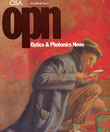
April 1998 Issue
Feature Articles
Optical Methods and Forensic Science
Forensic scientists rely on a number of optical techniques to identify and characterize material evidence from crime scenes. After discussing the forensic process and investigative methods and tools, Stoney predicts exciting developments.
by David A. StoneyForensic Examination of Explosive Materials and Aviation Security
Detection of explosive materials, whether in the lab or in the airport, to prevent a disaster or prosecute a perpetrator, is a specialized branch of forensics. This article looks at current and future techniques and instruments.
by Alvaro Mercado, Robin W. Hiley, Kevin L. McNesby, and Andrzej W. MiziolekInfrared Imaging In Law Enforcement
Infrared imaging can turn a seemingly quiet and abandoned warehouse into a scene of illegal activity. IR imaging technology and devices are comprehensively reviewed in this insightful article.
by Andrew P. OwenViewing Optics Express Movies on Unix
"This is so unbelievably cool. . . now I want to read the article so I can understand it," said an OSA member—after a half-hour of telephone coaching—when he first viewed a movie of the output beam patterns from a quasi-stadium-mode resonator on Optics Express. In that instant he understood how online journals, with their color, movement, and sometimes sound, can provide a new and potentially better way of conveying technical information. For instance, Figure 3 of that same article contains four curves, two of which mostly overlap. Without color, the curves would be indistinguishable. The member's enthusiasm was enhanced, no doubt, by a rapidly approaching conference deadline, but, even lacking a dire desire for diversion, you, too, will be pleasantly surprised the first time you view a multi-media Optics Express article.
by Bob JopsonSelf-focusing in Nonlinear Optical Media
Self-focusing and self-trapping in nonlinear optical media were discovered soon after the invention of the laser in the early 1960s. These phenomena explain the appearance of hot spots and associated optical damage in media irradiated by high power laser pulses. The high intensities achievable with the laser made it possible to observe these and other nonlinear effects that depend upon the change of the refractive index of the medium in response to the local electric field intensity.
by Masud Mansuripur and Ewan M. WrightZoom Enlarging Lens
Photographic enlargers intended for amateur or small volume use have a variable total conjugate distance distance because they use fixed focal length lenses. For high volume photoprocessing this is inefficient and a zoom lens is normally used to allow the total conjugate distance to remain constant. This month's design (see Fig. 1) is a two group negative-positive zoom with a fixed total conjugate distance that is suitable for making small enlargements of negatives ranging up to 56 X 41.5 mm (6 X 4.5 cm).
by J. Brian CaldwellOptics for the Fish
Helping students understand physical phenomena can be rather difficult at times. Everyone sees optical effects in the real world—reflections in a car's rear-view mirror, scattering making the sky blue, diffraction of street lights through a window screen, and Moiré fringes in household curtains. Many of these effects go unnoticed and are hard to bring into the lecture hall. I have developed a series of experiments using a water-filled fish tank to display principles of optics such as refraction, reflection, scattering, and interference, as well as demonstrate a simple water-based system for optical communication.
by R. John Koshel
![Illustration of optical skyrmions. [Y. Shen]](https://opnmedia.blob.core.windows.net/$web/opn/media/images/articles/2025/0525/departments/202505-cover-web.jpg?ext=.jpg)
![Illustration of a synapse in the brain. [Getty Images]](https://opnmedia.blob.core.windows.net/$web/opn/media/images/articles/2025/0425/departments/202504-cover-web.jpg?ext=.jpg)
![Fiber draped around a hand, demonstrating its flexibility. [Photo by Z. Wang and L. Wei]](https://opnmedia.blob.core.windows.net/$web/opn/media/images/articles/2025/0325/departments/202503-cover-web.jpg?ext=.jpg)